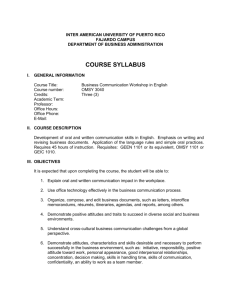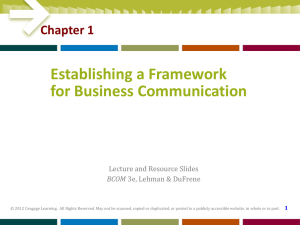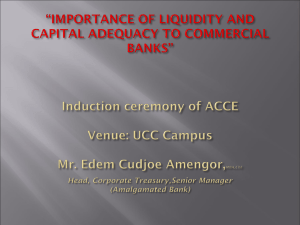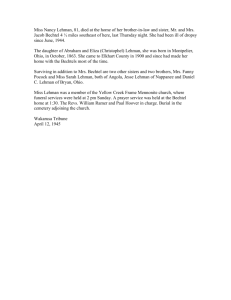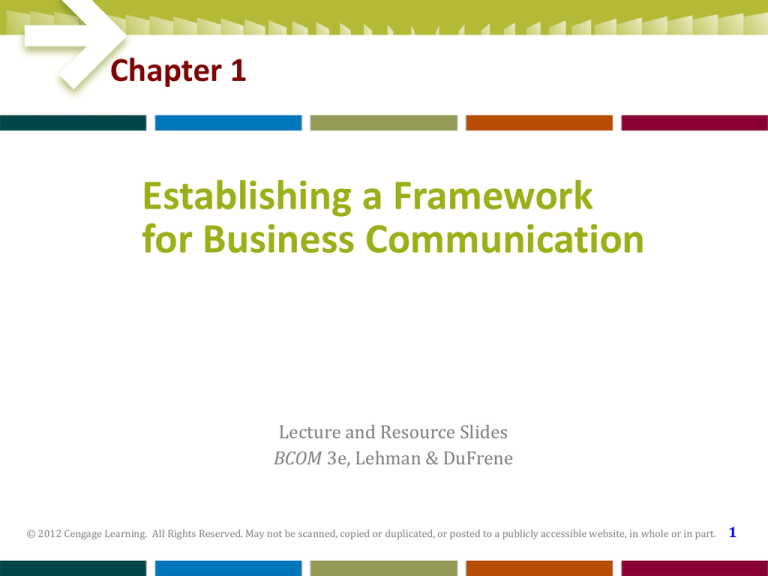
Chapter 1
Establishing a Framework
for Business Communication
Lecture and Resource Slides
BCOM 3e, Lehman & DuFrene
© 2012 Cengage Learning. All Rights Reserved. May not be scanned, copied or duplicated, or posted to a publicly accessible website, in whole or in part.
1
Learning Objectives
1. Define communication and describe the value for
communication in business.
2. Explain the communication process model and the
ultimate objective of the communication process.
3. Discuss how information flows in an organization
(formally and informally; downward, upward, and
horizontally; and through various levels).
4. Explain how legal and ethical constraints, diversity
challenges, changing technology, and team
environment act as a strategic force that influence the
process of business communication.
Learning Objective 1
Define communication and
describe the value for
communication in
business.
Purposes of Group Communication
• Achievement or task purpose
– To serve on a decision-making or problem-solving
group
– To get the job done
• Maintenance or social purpose
– To assist in the betterment of individual members from
a behavioral point of view
– To develop group morale
BCOM 3e, Lehman & DuFrene
© 2012
Cengage Learning
4
Learning Objective 2
Explain the communication
process model and the
ultimate objective of the
communication process.
Communication Process Model
BCOM 3e, Lehman & DuFrene
© 2012
Cengage Learning
6
Communication Process Barriers
• Differences in _________
education level,
experience, and culture
• Physical issues, such as _____or
noise room
temperature
• Mental distractions, such as developing a
listening
response instead of ________
BCOM 3e, Lehman & DuFrene
© 2012
Cengage Learning
7
Communication Channels
BCOM 3e, Lehman & DuFrene
© 2012
Cengage Learning
8
Selecting An Appropriate
Communication Channel
One-way
(email, letter, or
facsimile)
Two-way, not
face-to-face
(telephone); face-toface is ideal
Two-way or
one way, not
face-to-face
BCOM 3e, Lehman & DuFrene
• Request information needed to
provide services to client
• Tell customer order cannot be
delivered on date specified in
contract
• Inform sales staff of special sales
incentive
© 2012
Cengage Learning
9
Learning Objective 3
Discuss how information
flows in an organization
(formally and informally;
downward, upward, and
horizontally; and through
various levels).
Flow of Information
Within an Organization
BCOM 3e, Lehman & DuFrene
© 2012
Cengage Learning
11
Communication Systems
Formal
system
• Reflects rules and procedures
• Created by management to
control individual and group
behavior
Informal
system
• Emerges as people interact
within a formal system to
create a satisfying
environment
BCOM 3e, Lehman & DuFrene
© 2012
Cengage Learning
12
Dispelling Myths
about the Grapevine
• Grapevine is ___
no _____
more or ____
less
accurate than other communication
channels
• Message distribution is __________
networked
rather than linear in nature
BCOM 3e, Lehman & DuFrene
© 2012
Cengage Learning
13
Levels of Communication
Continued
BCOM 3e, Lehman & DuFrene
© 2012
Cengage Learning
14
Levels of Communication (cont.)
(cont.)
EXAMPLES
BCOM 3e, Lehman & DuFrene
© 2012
Cengage Learning
15
Learning Objective 4
Explain how legal and
ethical constraints,
diversity challenges,
changing technology, and
team environment act as a
strategic force that
influence the process of
business communication.
Strategic Forces Influencing Business
Communication
BCOM 3e, Lehman & DuFrene
© 2012
Cengage Learning
17
Causes of Illegal and
Unethical Behavior
•
•
•
•
•
•
•
profits
Excessive emphasis on ______
Misplaced
_________ corporate loyalty
Obsession with personal
_______ advancement
caught
Expectation of not getting ______
Unethical tone
____ set by top
management
Confusion about whether an action is
_________
wrong
Unwillingness to take a _____
stand
BCOM 3e, Lehman & DuFrene
© 2012
Cengage Learning
18
Examples of Illegal/
Unethical Behavior
Bernie Madoff
Cheated millions in Ponzi
scheme
AIG
Lucrative executive
bonuses
Enron, Worldcom, &
HealthSouth
Financial scandals
Toyko Electric Power
False reports to nuclear
regulators
BCOM 3e, Lehman & DuFrene
Other?
Former Illinois Governor
Rod Blagojevich
© 2012
Cengage Learning
19
Four Dimensions of
Business Behavior
BCOM 3e, Lehman & DuFrene
© 2012
Cengage Learning
20
Framework for Analyzing Ethical Issues
Identify the
existence of an
ethical issue
Identify an
alternative.
Is the
alternative legal
and does it comply
with relevant
contractual
agreements and
company policy?
YES
NO
Is the alternative
consistent with the
company’s and/or
the profession’s
code of ethics?
NO
YES
Select
another
alternative.
NO
Resource groups
Employees
Owners
Customers
Suppliers
Creditors
Government
Society
YES
Implement alternative.
Communicate ethical decision
and related action.
Chapter 1 BCOM 3e by Lehman and DuFrene
Copyright
Is the
alternative
ethical?
Revise code of
ethics if necessary.
2012 by Cengage Learning
21
Diversity Challenges
BCOM 3e, Lehman & DuFrene
© 2012
Cengage Learning
22
Changing U.S. Workforce
Age Demographics
BCOM 3e, Lehman & DuFrene
© 2012
Cengage Learning
23
Barriers to Intercultural
Communication
•
•
•
•
•
•
•
Ethnocentrism
Stereotypes
Interpretation of ____
time
________
Personal space requirements
Body language
Translation _________
limitations
Lack of language training
BCOM 3e, Lehman & DuFrene
© 2012
Cengage Learning
24
Impacts of Technology
• Aids in collecting and organizing data
• Helps craft clearer and more effective messages
• Overcomes distance and time issues
• Complicates interpersonal relationship
development
• Raises legal and ethical issues
BCOM 3e, Lehman & DuFrene
© 2012
Cengage Learning
25
Legal and Ethical Implications
of Technology
Information
Ownership
Information
Access
Threats to
Privacy
BCOM 3e, Lehman & DuFrene
© 2012
Cengage Learning
26
Team Environment Leads to Synergy
• Makes workers happier by causing them to feel
they are shaping their jobs
• Increases efficiency by eliminating
management layers
• Enables a company to
draw on talents of
entire workforce
BCOM 3e, Lehman & DuFrene
© 2012
Cengage Learning
27
Important Team Skills
• Problem-solving and goal-setting
• Conflict resolution
• Distributed leadership
• Commitment to evaluate the group process
• Ability to understand needs of coworkers
• Effective communication
• Ability to deal with barriers
BCOM 3e, Lehman & DuFrene
© 2012
Cengage Learning
28
Communication Patterns
for Successful Teams
• Trust-building changes _____________
communication patterns
• _____
Open meetings educate employees
• ______
Shared leadership involves management and
employees
• Information flows ___
up to management, down to
workers, and ___________
horizontally among teams
BCOM 3e, Lehman & DuFrene
© 2012
Cengage Learning
29

